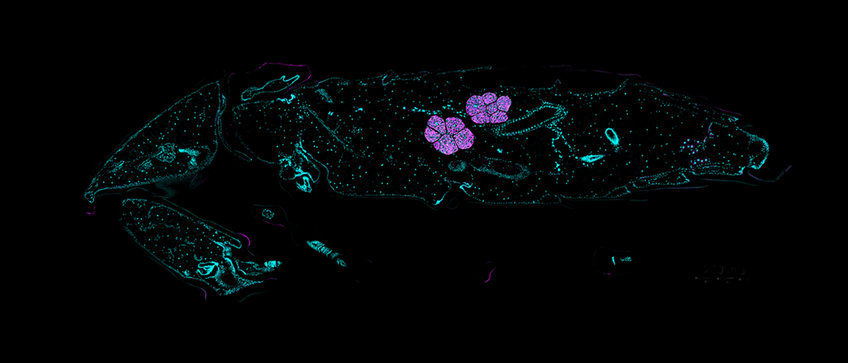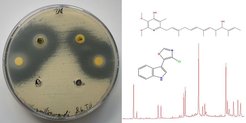
Chemistry of Insect Microbe Interactions
Dr. Tobias Engl and his Research Group
Like all animals, insects can interact with various microorganisms in a mutualistic or antagonistic manner. We are interested in the ecological, evolutionary, and functional aspects of these symbiotic relationships in different insect groups, especially Coleoptera and Hymenoptera.
Molecular integration of nutritional symbionts
A surprising number of grain pest beetles live in symbiotic associations with bacteria or yeasts that supply their host with nutrients like amino acids and vitamins. The cuticle represents an insect’s primary defense against natural enemies and abiotic stresses and is in many beetles influenced by a symbiotic supplementation of aromatic amino acid precursors. Especially Bacteroidetes bacteria, also known as vital symbionts of the Blattidae and Auchenorrhyncha, were recently described to be a prevalent symbiont of multiple beetle families, including the Bostrichidae, Silvanidae and Throscidae. We could demonstrate that this symbiosis supports the cuticle synthesis and thereby has a significant impact on the beetle survival and establishment. The symbiotically enhanced cuticle has not only a beneficial effect on the defense against predators and pathogens, but also on desiccation resistance in their usually dry habitats. However, this contribution also represents a weak link for these beetles. The symbiont is highly susceptible to elevated temperatures, antibiotics, but also the agronomically applied herbicide glyphosate. We investigate the ecology and evolution of these symbioses, with an additional focus on the functional integration and control of the symbionts in the host metabolism, especially in cases where two or more symbionts provide complementary or redundant contributions. To this end we employ state of the art molecular and imaging techniques, especially fluorescence in situ hybridization and micro-computer tomography, genome, transcriptome and chemical analyses, experimental manipulation of the association, and various bioassays.
Involved researchers: Soumi Bhattacharyya (doctoral researcher), Dongik Chang (doctoral researcher), Camila Fiori Perreira (doctoral researcher), Nomthandazo Kanyile (doctoral researcher), Jürgen Wierz (doctoral researcher),
Antimicrobial defense strategies
Our work on the chemistry of antagonistic insect microbe interactions focusses not only on symbiont provided compounds, but also on host produced ones beyond the classical immune system and environmentally acquired ones. We focus on the question how ground nesting Hymenoptera, e.g. local solitary bees, or the North American alkali bee Nomia melanderi, deal with detrimental soil microbes. The defense strategies of the European beewolf Philanthus triangulum are especially well studied. These include the host’s own antimicrobial fumigation via nitric oxide, and defensive Streptomyces symbionts, that both protect food provisions and the juvenile life stages against detrimental mold fungi. Beewolves sterilize their brood cell with nitric oxide, a highly reactive radical, which not only suppresses mold growth, but also exerts high pressure on the symbiont. The symbionts on the other hand provide protection during hibernation of the larvae and metamorphosis by impregnating the cocoon with a conserved cocktail of antibiotics that serves as a combination prophylaxis against soil molds. We want to elucidate the symbionts’ physiological reaction to the repeated nitric oxide exposition as well as the evolutionary consequences of the adaptation to this challenging lifestyle. We are further interested in the long-term use of the prophylactic antibiotic cocktail in a natural system. How does diversity and variability differ in such a natural blend between several beewolf species? Further, how do different components interact with each other, regarding effectiveness against single pathogens and the entire spectrum of inhibited mold fungi. Involved techniques are beside sequencing approaches also chemical analyses and inhibition assays of microbial growth.

Involved researchers: Chantal Ingham (doctoral researcher, JGU Mainz), Bernal Antonio Matarrita Carranza (doctoral researcher), Noel Sillo (Kompetenzzentrum Wildbienen)
Collaboration partners
Besides multiple researchers within the department, these projects are run in collaboration with:
- Abdelaziz Heddi, Anna Zaidmann, Severine Balmand, BF2I, INSA Lyon
- Aurelien Vigneron, Université Lyon
- Jean Keller, Université Toulouse
- Julian Kiefer, MPI for Marine Microbiology Bremen
- Rayko Halitschke, Mass Spectrometry, MPI-CE Jena
- Veit Grabe, Microscopy Imaging, MPI-CE Jena
- Petri Turunen, Sandra Ritz, Microscopy Core Facility, IMB Mainz
- Vincent G. Martinson, University of New Mexico
- Philipp Bauer, LTZ Augustenburg / Universität Hohenheim
- Cornel Adler, JKI Berlin
- Karen Kapheim, Utah State University
- Takema Fukatsu, AIST Tsukuba
- Erhard Strohm, Universität Regensburg
